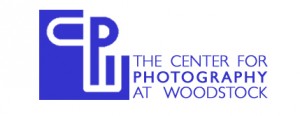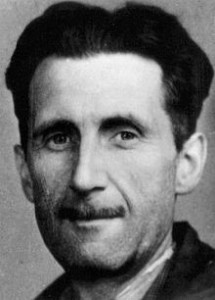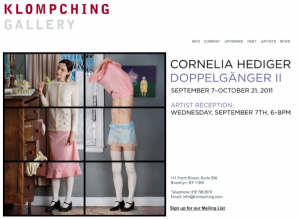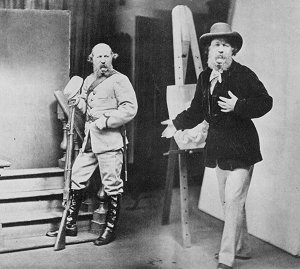In his 1946 essay “Politics and the English Language,” George Orwell famously proposed that spoken and written clichés functioned to supplant critical thinking. He cited numerous catchphrases that, in his opinion, had come to infect English, his own language. His argument certainly applies to other languages as well. But it also applies to other forms of communication, all of them subject to infestation by what I’m here calling tropes — recurrent formulations and structures deployed to evoke knee-jerk responses rather than to express new ideas and provoke new thoughts.
Assuredly, as I’ve tried to point out in this series of posts, photography has accumulated a plethora of its own tropes, their explosive growth encouraged as ever by any environment in which the jargonized and scientistic combine with the doctrinal. The present-day academic-art context thus provides the perfect fertile medium for their incubation and dispersal. This milieu functions, per Orwell, to suppress “criticality,” not to further it.
Mind you, if asked whether I agree or disagree with the proposition that every single microculture and manifestation of social life on the entire planet merits documentation, even if in an absolutely predictable, pre-fab, formulaic, cookie-cutter way, I’d probably say yes, on principle. After all, who am I to judge whether our present and future need for societal annotation will get better served by a small catalogue of women with their firearms or an equivalent aggregation of images showing girl children with pink stuff? Do parents whose children have left the nest merit less attention, now or later on, than people in prison in Louisiana?
But that doesn’t mean I want to spend time with each and every one of those projects simply to demonstrate that, in some wishy-washy liberal way, I “care about” the subjects — especially if the structure of the project, and the structure of the imagery, reeks of the generic.
•
In the first post in this series, I cited, as an example of a trope conceived by academically certified photographers, several projects premised on the notion that the same person appeared more than once in each image. I dubbed this conceit the “Doppelgänger” trope, using the German term for the idea that a person has a double somewhere in the world. The two examples I gave, Kelli Connell’s “Double Life” series and Rick Odell’s “My Better Half” series, do not specifically use the term “Doppelgänger” in their accompanying statements.
Since then I’ve discovered the work of Veronika Marquez and Tomoko Sawada, also energetically milking this same cow. Add to that list Cornelia Hediger, who had a show by that name, “Doppelgänger II,” at the Klompching Gallery in Brooklyn’s DUMBO district, opening September 7 of last year. For the gallery’s press release, click here. An extract from the hype:
“With this newly released series of photographs, Hediger continues her exploration of the uncanny, constructing complex pictorial narratives into segmented tableau vivants (sic), consisting of up to eighteen individual photographs combined into a single composition. In each artwork the central characters — doppelgängers — are interwoven into a performative psychological struggle, displaying an undercurrent of the sinister, of angst and moral ambiguity. The relationship between the two central characters is superbly enacted by the artist herself, drawing comparisons in visual and conceptual strength to the work of historical photographers such as Claude Cahun.”
Hediger received her MFA in 2000 from the Mason Gross School of the Arts at Rutgers University. From her resumé, it appears she premiered her first “Doppelgänger” series in 2007, beating Connell, Odell, and Marquez to it. Given the access to information the internet enables, I find it hard to imagine that these picture-makers don’t know about each other’s projects.
But Yasumasa Morimura had already mined that vein in the late ’80s, and O. G. Rejlander got there over a century before that, with his 1871 self-portrait “OGR the Artist Introduces OGR the Volunteer.” With the emphasis placed on awareness of the medium’s history and field of ideas in the photography BFA/MFA system, and the resources now available toward that end, I find obliviousness to historical precedent, and/or failure to acknowledge it, inexcusable. That goes for gallerists and others writing publicity materials for marketing purposes, as well as for the photographers themselves.
The Rustle of His Wings
 In that same July 5 post launching this series I predicted that a survey exhibition based on the “Doppelgänger” trope would take place soon. This prophecy almost immediately came true, with the July 14 opening of the current show at the Center for Photography at Woodstock titled “Doubles, Dualities & Doppelgängers.” (I received no advance notice of this project.)
In that same July 5 post launching this series I predicted that a survey exhibition based on the “Doppelgänger” trope would take place soon. This prophecy almost immediately came true, with the July 14 opening of the current show at the Center for Photography at Woodstock titled “Doubles, Dualities & Doppelgängers.” (I received no advance notice of this project.)
The CPW group show casts a net wider than the conceit of staged images with a single model playing multiple roles, represented therein by Kelli Connell, Cornelia Hediger, and Ruud van Empel. It also includes images of twins by various photographers, including a few sets of twins who have photographed each other. Still, I’d say this validates my forecast, emboldening me to issue more. Stay tuned for my prediction on the outcome of the 2012 presidential election.
Tristes Tropes
Some of the core ideas I’ve expressed in this series of posts made their way into an odd post at Art Participant, a blog published by the Berkeley, CA private dealer/gallery Charles Guice Contemporary. I consider the post curious because while listed under “Reviews,” bearing a review-like title (“Eufália Cristina Paz de Almeida: An Artist Finds Her Method”), and reading like a review, it gives no indication of where and when the work it discusses was exhibited or otherwise seen by the reviewer, and is unsigned and undated. (From the indication of how long ago it got posted, I calculate the publication date as July 27.)
Poking around the blog, I learned that Art Participant was “developed to facilitate dialogue about the gallery’s artists and their work, as well as about photography, culture and art in general. The views expressed here are those of the gallery, its owner, and of the contributors.” Presumably, then, the author is Charles Guice himself. It’s impossible to tell from the blog, or from the website for Charles Guice Contemporary, whether this dealer represents Paz de Almeida, or plans to do so. Regardless of the answer, I consider it inappropriate — indeed, deliberately misleading — for anyone in the marketing sector of the field to publish anything self-authored and titled a “review” at a website sponsored by his or her commercial enterprise. Doing so anonymously compounds the error, muddying the waters even further.
Anyhow, putting all that aside, the “review” contains the following passage toward its end:
“Paz de Almeida’s series is not the photographic narrative we have become accustomed to seeing. It does not fit comfortably within the framework of the well-made project nor do the photographs: the primary subjects (here alone breaking formula, there is more than one) do not receive central placement within the frame.
They are not the largest element, they are not addressed frontally or head-on, and they aren’t always in sharpest focus. For some, arguably, the photographs might even be considered banal or boring.”
All of which comes pretty much verbatim from my commentaries, as the link Guice included indicates — except for the last sentence, which suggests that the pictures in question “might even be considered banal or boring” because they don’t conform to the trope. Whereas I’ve emphasized that conformity to the trope engenders viewer boredom (mine, at least). I’m glad whenever someone finds a concept of mine useful, but chagrined to discover it deployed in such a murky context.
•
This series has provoked the estimable Peter Marshall to comment on it and reminisce about his own early encounter with one of the tropes in question during a beginner’s class in photography decades ago, in an August 10th post titled “Trope” at his blog, Re: PHOTO. Marshall’s always worth reading.
•
Bryan Formhals, Social Media Manager at B&H Photo, excerpted my definition of the most common visual trope in his July 22 post, “Photography and Progress,” for LPV Magazine, which he founded and edits.
•
(For an index of links to all posts in this series, click here.)
•
This post supported by a donation from the Estate of Lyle Bongé.












Another trope that seems to be flourishing is the “Street Photography” image, the majority of which to my mind are utterly commonplace, revealing nothing of interest. It seems as though an image need only be shot on the street, be adequately exposed, and be more or less in focus to warrant the legitimizing label of “Street Photography.”
The term “street photography” has always served simply as a category of imagery, like portrait photography, landscape photography, still-life photography, etc. It’s never served as a guarantee of quality or a stamp of approval. As with much of what’s produced in any form or genre of imagery, the vast majority is mediocre and eminently forgettable.
But a genre’s not a trope. The term “trope” refers to more specific and delimited visual approaches. Within any form, tropes emerge. For example, curator Anne Wilkes Tucker of the Museum of Fine Arts, Houston, speaks derisively of an image archetype she calls “crotch in the wilderness,” which she describes as “pictures of languid [female] nudes in ivy beds, pools, or sand dunes.” Definitely a trope.
Point taken on the proper use of “trope.” On “Street Photography,” perhaps is my lack of sufficient reading of photographic literature but it does seem to me that the label has gained its present level of currency only in the last decade or two, this possibly related to the existence of the internet. On the label providing a stamp of approval, it doesn’t. It does seem, however, that many photographers working in the genre believe that, because the label applies, they somehow have a leg up.
The term “street photography” was already in widespread use when I started writing about the medium in 1968. I can recall getting interviewed on that subject (using that term) for a short-lived “little” magazine circa 1971. Due perhaps to the “New Documents” show at MoMA in 1967 — where John Szarkowski put his imprimatur on Winogrand, Friedlander, and Arbus — the genre had considerable credibility and visibility by 1970, though I don’t think Szarkowski actually used the term in his curatorial essay.
Bystander: A History of Street Photography by Colin Westerbeck and Joel Meyerowitz, originally published by Bulfinch Press in 1994, was the first survey of this mode or genre. That’s almost 20 years ago. So I’m not sure what you mean by this label’s “present level of currency.” If you mean simply the number of people using that label to describe their own work, then the causes are probably (a) the sheer number of photographers cranked out today by the photo-ed system internationally, (b) the need to label oneself that the fine-art photography system generates, and (c) the internet as an available and inexpensive system for distribution of their images and the accompanying self-promotion.
Using that label doesn’t give anyone a leg up, in my opinion, especially considering the sheer number of people who self-identify that way. It does suggest that they’re consciously working within and cognizant of a tradition, and one that’s unique to photography, much as plein-air painting is unique to that medium. None of which makes the pictures any better or worse.
Well, as I suggested might be the case, my feeling that the term is newer than I thought is a result of the limitations of my reading. I do have “Bystander…” and now I’m inclined to get it off its shelf and spend some time with it. Best Regards, njb
does the trope need to written to be understood? or is it the visual understanding of the photographer at that moment in time. The art is that which you see through the canvas/Photograph that is placed in front of you, the Metaphor/trope in which the artist is visually describing might not always be seen by those on looking, in this case “Street Photography” this does not mean it isn’t trope or art. surely trope is any form of art which can be characterized as a type of Metaphor/Trope by its creator, rather than that of the onlooker?
You are comparing apples and oranges.
Metaphor: A figure of speech in which a word or phrase is applied to an object or action to which it is not literally applicable. A thing regarded as representative or symbolic of something else.
Trope (as most commonly used nowadays, and as used by me in this series): A significant or recurrent theme; a motif.
It has nothing to do with taking written form (or not), nor with the photographer’s “understanding at the time,” nor with “art” (whatever we might agree that means). When you photograph 25 objects (people, things, etc.) in the same way – same format and lens and film, lighting, distance from camera, placement in frame, depth of field, etc. – and present the resulting images as a group, you are employing the trope of typological cataloguing.